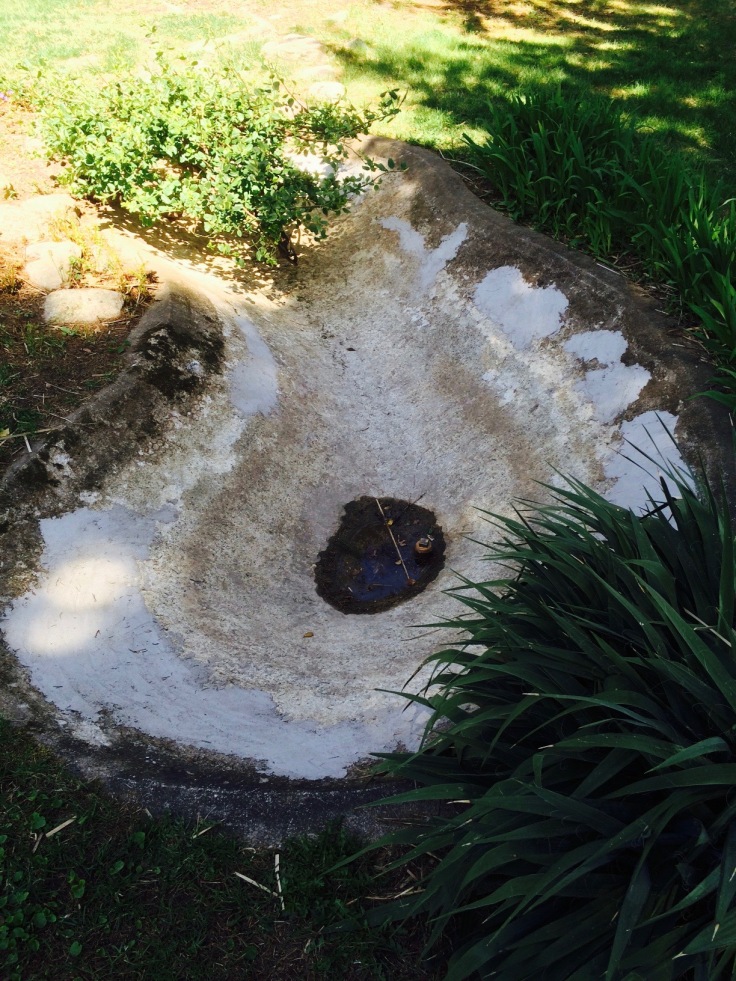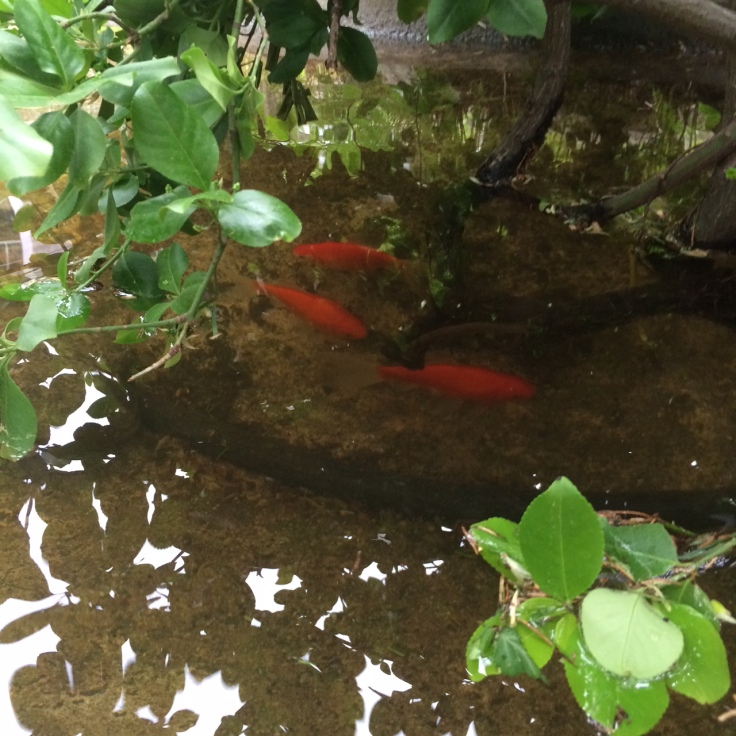When we moved into the tired Victorian on Brush Hill Road we were told there was an old koi pond on the property. But the only evidence was a thicket of tall reeds that turned brown in autumn, sprouting from a bog of sodden earth that was bordered by a rim of cement. I didn’t give it much thought.
The fact is, for the first five years we lived in the old house, there was so much repair work to do—basic structural work, endless hours of stripping paint, and even more hours of painting and carpentry work and refinishing—that I couldn’t have turned my attention to the pond even if I had wanted to.
One day that changed. For whatever reason, I decided this was going to be the day I found out what the hell was going on beneath all those reeds. I didn’t know it at the time, but that was the beginning of what would become a deep appreciation for the mystery of nature.
The restoration
I began by putting on knee-high rain boots and hacking at the root system of all those reeds. I carved it up like a giant tray of brownies, standing on the lips of the shovel with both feet and hopping up and down until I struck bottom, often more than a foot below. Once I had carved out a square, I’d use a hoe to yank at a corner until, with a sickening sucking sound and a noxious smell, the wet earthen roots came away from the bottom of the pond.
Hour after hour I toiled away, wrestling my heavy, soggy bundles into a wheelbarrow and depositing them in a distant corner of the property, only to take up the shovel and cut another square. When all the mud and all the roots were gone, only a shallow pool of slimy water remained. I used a pump to suck out the dirty water and hosed down the basin. What I saw was remarkable to behold.
The pond basin, now completely empty and clean, was made entirely of cement. Potentially a century old, judging by the age of the house, the structure was kidney shaped with artfully sloping sides and a rounded bottom that curved down to a depth of nearly three feet at its deepest and widest section. The flat rim around the edge of the pond was about half a foot in width, cast from the same material but entirely smooth. From shallow end to deep, the pond measured 17 feet long and was nearly 7 feet across at its widest part. This was a serious pond! A old euonymus shrub grew over the shallow end of the pond with its root system safely outside of the basin. This would provide a good hiding place for fish.
I spent the better part of a week patching some cracks in the pond basin with new cement, and letting it thoroughly dry out in the sun. A threaded pipe poked out an inch or two from the center of the basin at its lowest point; it was obviously a source of water at one time, but now it was densely packed with oily dirt. Finding no connection in the house, I decided to simply cap the pipe and move on. It was time for water.

Paradise Water Gardens in Whitman, Massachusetts, was a ramshackle affair of algae-plagued outdoor ponds and a dilapidated main building that housed the pond supplies and several tanks of fish and plants. The proprietors looked as though they were returning to the primordial goo themselves, but they were pleasant and helpful, and I was in no position to be picky.
After I described the pond, they recommended a waterfall pump and filtration system that would both circulate water in the pond and keep the water clean. An electric pump placed at the deep end of the pond would suck in water and send it through a submerged tube to the shallow end, where it would pass through a series of filters before spilling over the waterfall and back onto the surface of the pond. The splashing water is key; fish need oxygenated water to breath, and the waterfall delivers by generating bubbles day and night under the shade of the Japanese euonymus. It also sounds great. After installing the waterfall system and burying the electric cord that ran to an outlet outside the house, I filled the pond with its first batch of clean water. Now it was time for fish.
The fish
Back at Paradise Water Gardens, I picked out several water lilies and three small fish called comets. More goldfish than koi, they were cheap and hardy and said to grow to a maximum length of about a foot in adulthood. They were exceedingly shy at first, hiding beneath the euonymus for hours on end, but eventually they got accustomed to their new home and ventured out into the deep. The lilies were planted in clay pots with soil and a layer of gravel to keep the dirt from falling out under water. I arranged them on the bottom to provide maximum coverage as the lilies grew and spread across the surface of the pond. Fish are shy and defenseless critters; the lilies provide shade from the sun along with ample places to hide.

In addition to being naturally shy, fish really do adopt a school mentality, swimming together wherever they go, and darting away in unison at the first sign of the danger. My fish grew substantially that first year and were especially active in warm weather. I fed them koi pellets in the early morning and at dusk when they seemed most likely to be out and about, pecking the sides of the pond for algae and bugs.
One of the most fascinating experiences I had with my fish was watching them winter over in the pond. Here in Boston, we get real winter, and I was told that as long as I kept a hole in the ice for air to pass through, I’d have no trouble keeping the fish out there all winter under the ice. Fish are cold-blooded so they adapt to the temperature of the water by slowing their metabolism and all bodily functions until they reach a state of torpor. They rest at the bottom of the pond—which in winter is the warmest part—and barely move for months. No eating or unnecessary swimming, they simply conserve energy and wait until the spring thaw.
All three of my fish made it through the winter and into spring only to be eaten by a heron one fine April morning. Spring is a dangerous time for the fish because the lilies have not yet sprouted pads, so the fish have no protection from the sky outside of the euonymus. My son spotted the heron when pulling into the driveway with his mother just back from an errand. “Gee, that’s a big bird down by the pond,” he said, and then the heron folded up its long legs and flew away with a belly full of comets. C’est la vie. Bird’s got to eat, too. I waited until the lilies had grown over and then restocked the pond with new fish, selecting three with a good deal more camouflage in their coloring.
The birds, the bees, and the biology
To me, the most interesting goings on in the pond are not from the fish I purchased but from the animals that come uninvited. The pond is a regular stop for all manner of birds who drink from its cool water and bathe to varying degrees depending on the species. The cardinal will ruffle its feathers quickly and depart to a nearby tree to dry, while the robin practically swims around in the water, splashing and carrying on with abandon.
Honey bees are also frequent visitors, particularly in warm weather. A hive can drink a quart of water in a day I’m told; some of the water is used to help with the production of honey, some to cool down the hive. Fearful of open water, the bees that visit the pond congregate by the dozen on the mossy banks and on the lily pads, occasionally stopping for some pollen in the lily flowers. Never bumble bees or hornets or other stingers, only honey bees come to visit. Curious.
The most mysterious aspect of the pond—and the most humbling—is the water itself. A pond needs naturally occurring bacteria to maintain clear water. This bacteria congregates in the filter and breaks down the minute particles of organic matter. If the bacteria subsides, your pond water will quickly turn brackish and become nearly opaque. This happened to me not long after the new fish were installed, and I was desperate to find a remedy. I tried a half dozen chemical treatments, I cleaned what I could see in the pond, and I changed the filter relentlessly, but nothing seemed to work. Nothing, that is, except time. It seems the bacteria want only the chance to establish themselves on their own terms, without you messing about with a pond vac and good intentions. I went away on a two-week vacation, and when I returned the water was crystal clear. Fascinating.

These days my approach to pond maintenance is more gentle nudge than total immersion. I understand that nature is doing most of the work; my job is to get out of its way and watch the magic.
Leave a comment